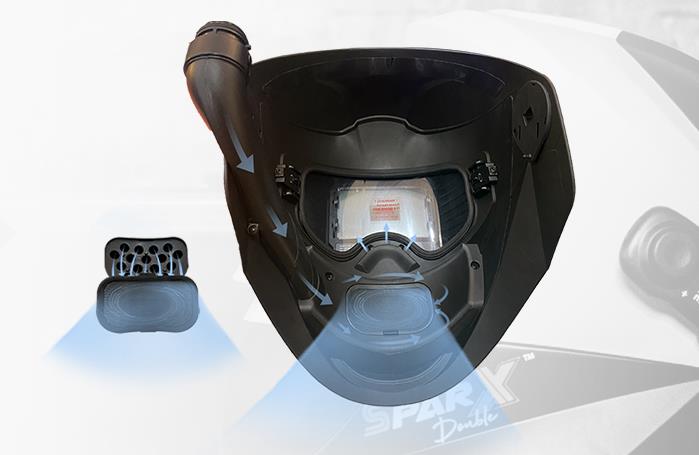The concept, classification and key indicators of papr respirator
The papr respirator is a type of filtered respiratory protection equipment that relies on electric fans to overcome the resistance of respirator components. As papr can effectively improve the comfort of users, enhance the reliability of protection, and improve work efficiency, this type of product is widely used in many industrial productions, public safety and other fields, with the increasing demand for the application of various papr products in various regions, related enterprises also report great enthusiasm for papr product development.

1. papr respirator compared with self-priming filter respirator.
(1) the addition of an electrically powered air supply device to reduce the user's respiratory load to improve their comfort, more suitable for higher labour intensity of the operational needs.
(2) The respirator mask can maintain a positive pressure breathing environment in higher air supply conditions. It can effectively prevent external contaminated air from leaking into the mask during the inhalation process, improving the reliability of protection.
(3) Loose-fitting masks (such as open masks and air delivery hoods) that do not require close fitting with the face can be used, thus improving the fit and comfort of the respirator and personnel.
(4) Respiratory, eye, face and head protection can be combined to achieve comprehensive occupational safety protection needs.
Although the papr respirator has a good value for promotion and application, due to the high degree of technical integration, resulting in high use and maintenance costs, largely restricting the use of units for the enthusiasm and enthusiasm of the operators to choose this type of product. In addition, papr respirators, like self-priming filter respirators, are not suitable for use in IDLH environments with oxygen concentrations below 19% or high chemical hazards (immediate threat to life and health) and should be selected in strict accordance with the requirements of the correct.
2. Classification of papr respirators.
There are more types of papr respirators. Usually, according to the type of mask, papr respirator can be divided into three categories: closed facepiece, open facepiece and air delivery hood.
(1) closed-type mask
a) Half mask
b)Full facepiece
(2) open type mask and air supply hood two types can also be called loose with type mask. Any open-type mask or air supply hood can also contain a helmet to provide the head and face against mechanical impact hazards.
(3) According to the air supply effect (i.e., the pressure pattern inside the respirator mask)
a) Positive pressure type
b) negative pressure type. PAPR classification is shown in the table
(4) Classification of filter elements
a) Particle protection class
b) Single or multiple gas/vapour protection category
c) Combined gas and particulate protection
3. Key technical indicators of papr respirator.
(1) Air delivery volume.
The protection ability of the papr respirator is closely related to whether the air environment of the user's mouth and nose is "positive pressure", and the positive pressure is directly related to the actual breathing volume of the user, i.e. labour intensity. The future ISO respirator standard is also trying to link the protection capacity to the labour intensity. Taking into account this development trend and the comprehensive cost factor, the air supply effect is categorized into auxiliary air supply (i.e. "negative pressure" mode) and forced air supply (i.e. "positive pressure" mode). Two modes. Auxiliary air supply focuses on improving the user's respiratory load. It is more suitable for low-intensity operations, while forced air supply focuses on reducing the user's respiratory load and improving the reliability of protection and is more suitable for medium and above operations.
The minimum air supply volume of positive pressure PAPR with a closed mask should be at least 95L/min, and the minimum air supply volume of negative pressure PAPR with a closed mask should be at least 45L/min; the minimum air supply volume of PAPR with an open mask or air supply hood should be at least 120L/min.
(2) Protection time.
Protection time refers to the time under the specified test conditions, from the beginning of the test medium into the filter element to the test medium through the concentration to reach a limited value. Compared with self-priming filtered respirators, the design airflow requirements of Ppapr respirators lead to changes in the protection time test conditions of the filter element, which indicates that the protection performance of any supporting filter element used in Ppapr respirators should be re-evaluated according to the effective airflow or the initial actual airflow of the PAPR.
The design characteristics of Ppapr respirators are mainly to improve the comfort of the wearer and increase work efficiency while ensuring a certain level of protection. Therefore, the protection time of the filter elements used in these products is generally shorter than that of ordinary air filtration products under the same conditions. In addition, the protection time requirement specified in the standard is only the protection capacity of the filter element obtained under laboratory test conditions. It does not represent the protection time obtained under the actual conditions of use. With the different conditions of actual use of the filter element, the protection time may differ from the protection time under the test conditions determined by this standard, which may be longer or shorter.
The above is about the concept, classification and key indicators of papr respirator. If you need more detailed information, welcome to contact us!





